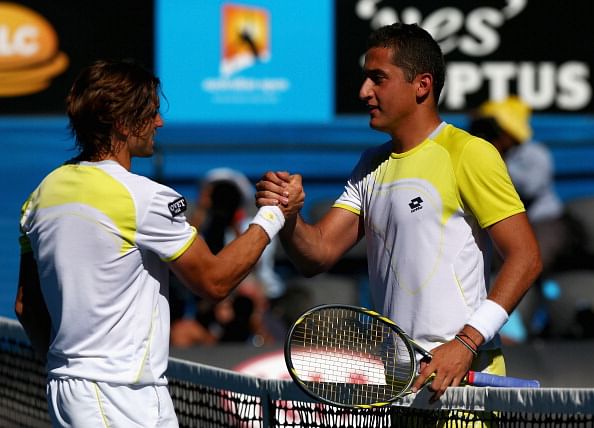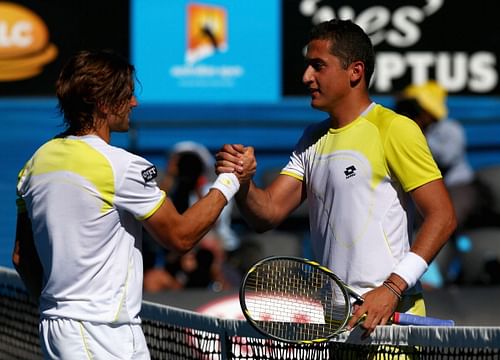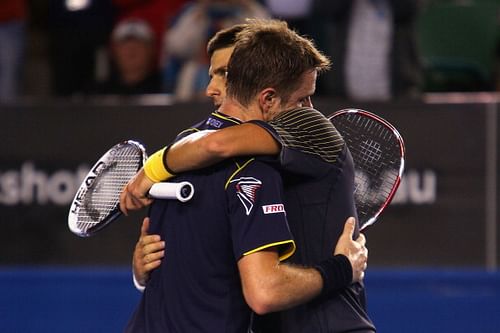
Australian Open shows that a five-set epic is not always an epic

David Ferrer and Nicolas Almagro after their torturous quarterfinal battle
Nicolas Almagro‘s dogged attempts at entering the Self-torture Hall of Fame today made sure of one thing: the 2013 Australian Open would get to witness yet another five-set marathon. The five-set battle in tennis is not just a match; it’s an event. The fact that it can, theoretically, go on till the end of time, adds a certain mystique to it that elevates it from a mere match to the ultimate test of endurance. And the participants of such a match don’t remain players anymore; they become gladiators who seem ready to die rather than give an inch to the opponent. Yes, the five-setter has become the sensuous preserve of tennis that makes the sport intriguing, intense and inspiring – all at the same time – in a way that very few other spectacles in the world can match. But looking at the quality of some of the five-setters we’ve seen in recent times, I’ve started to think we might be better served if we refrained from throwing around words like ‘epic’ and ‘classic’ too easily in relation to these matches. Even if they do end with a fabulous scoreline like 8-6 in the fifth.
Today’s five-setter between Almagro and Ferrer was, for lack of a better word, exasperating. Almagro played some breathtakingly beautiful tennis to go up by two sets and a break, but with victory in sight, he proceeded to show the ugly side of his game and let Ferrer back into the match. And Ferrer didn’t exactly take full advantage of Almagro’s gifts; he himself was suffering a rare off-day, and at one point was finding it easier to break serve than to hold. The match twisted and turned in random, meaningless fashion with neither player able to assert his authority. Almagro served for the match as many as three times – once in the third set and twice in the fourth – but every time he stepped up to win that pivotal last service game, he looked as likely to seal the deal as Barack Obama does of sprouting wings and singing Aqua’s Barbie Girl song. By the time the 4th set ended, Almagro’s body gave up on his already foundering mind, allowing Ferrer to win a routine 5th set that was neither intense nor particularly interesting.
This wasn’t the first underwhelming five-setter of the tournament, of course. Three days earlier, Gilles Simon and Gael Monfils scripted one of the most snooze-inducing sporting contests you’ll ever get to see, a match that featured 71-shot rallies and generally purposeless tennis. There were also numerous injury time-outs and a host of unsightly antics displayed by the two protagonists which made you want to either tear your hair in frustration or smash your TV with a baseball bat. This match was an epic, yes. An epic fail.
The 4th round match between Novak Djokovic and Stanislas Wawrinka was a lot better in quality, but count me among those who were surprised to hear people calling it an instant classic. The match did feature some otherworldly tennis, but it also had its share of cringe-worthy moments. Wawrinka shrinking away from the challenge when in position to serve for a two-sets-to-love lead wasn’t exactly the stuff of folklore, and neither was the alarmingly high number of unforced errors that came off his racquet – 93. Djokovic, for his part, played well below his best for vast stretches of the match, and the sitter forehand that he botched into the net on break point at 4-3 in the fifth set would have rankled long and hard if he had lost the match. There was plenty of heart on display, yes, but that didn’t always translate into great tennis. You probably couldn’t blame either player for that – 5 hours on a tennis court is a long time by any standard – but ranking the match among the greatest tennis battles of all time is unfair to all those other matches that have so deservedly found their place in the list. It was particularly surprising to hear people compare this match with the 2009 semifinal between Rafael Nadal and Fernando Verdasco, which, at least according to me, was light years ahead in terms of quality.

Novak Djokovic and Stanislas Wawrinka after their marathon 4th-rounder
There is one school of thought that the current combination of slow courts, advanced racquet technology and emphasis on defense necessitates that every evenly-contested tennis match turns into a play-till-you-drop battle of attrition. That’s a valid argument, to an extent. When all of your potential winners come back with interest, making an error becomes the only way to win a point; consequently, players can’t help but end up with a huge number of unforced errors. But there’s also something to be said about a player expanding his creative horizons to find ways to win points when there don’t seem to be any. Attacking the net, using variations such as the slice or the dropshot, altering spins – all of these sound like part of a holier-than-thou purist’s rant, but when you see matches that go on and on with mind-numbing repetitiveness, you feel inclined to hop on to the purists’ camp, if only for a little while.
Admittedly, Wawrinka did employ a fair bit of variation throughout his match against Djokovic; the Serb’s defense was just so good that all those sliced backhands and volleys could ultimately do nothing to shorten the match. But playing the same brand of tennis over and over again, even when it is not working – the way Monfils and Simon did – is just a bad advertisement for the game. The same logic applies, if to a lesser extent, to the semifinal last year between Djokovic and Murray, as well as – I’ll just go ahead and say it – the much-celebrated final between Djokovic and Nadal. Five hours of back-breaking tennis sounds admirable, even heroic in theory. But in reality, five hours of one-note, excruciatingly physical play exacts a needlessly high price from your body (Nadal has been absent from the tour since July), and to make matters worse, it does nothing to bring more fans to the sport.
Playing a tense five-setter will always be a feat worthy of a place at the pinnacle of athletic achievements across all sports. But calling every prolonged five-set match an epic is probably not the best way to remember those matches. And it certainly isn’t the best way to do justice to the word ‘epic’.